Back
In Russian
Codex of Inscriptions Index
Alphabet Index
Roots
Alphabet
Writing
Language
Religion
Geography
Archeology
Religion
Coins
Wikipedia
Codex of Inscriptions - Index
Hunnic Writing
Turanian Writing
Paleography of 8 Türkic Alphabets
Codex of Inscriptions-Euro Asiatic - Don
Codex of Inscriptions-Euro Asiatic - Kuban
Codex of Inscriptions-Euro Asiatic - S. Enisei
Codex of Inscriptions-Euro Asiatic - Isfar
Avar Dateline
Besenyo Dateline
Bulgar Dateline
Huns Dateline
Karluk Dateline
Kimak Dateline
Kipchak Dateline
Kyrgyz Dateline
Sabir Dateline
Seyanto Dateline
Türkic Scripts - Codex of Inscriptions
Euro Asiatic Subgroup
Kuban Script
(see also
Balkarian)
Introduction
I.L Kyzlasov in his book Writings Of Eurasian Steppes assembled a Codex of Inscriptions. The Euro Asiatic group, per I.L Kyzlasov, includes Don, Kuban, S. Enisei, Achiktash, and Isfar scripts.
I.L Kyzlasov attributs the Kuban script to the Bulgarian states (including the Itil Bulgaria) and Khazaria in the period of 8-th - 12-th c.
Codex of Inscriptions - Kuban
2. THE KUBAN SCRIPT (К)
K 1. Sedjar
Engraving on the vertical handle of a silver üg. The
remains of two lines, a part of the handle (length about 7 sm) lost after
finding of the vessel, a part (length about 1 sm) lost later. In the beginning
of the first line nowadays is only the first letter (on the sketch of 1884, two
and a fragment of the third letter), was separated from the others by a lacuna
no more than in 15 (originally 13) signs. On a sketch of 1896 two of these
signs are known. Other part of the line contains 17 signs. The preserved
initial part of the second line consist of four signs. Height of letters
0,5-0,7 sm (one - 0,3 sm). The text is preceded with an ornamental figure.
Date - 8-10 century.
Found June, 6, 1884 at plowing near village Sedjarskaya (nowadays v. Sediar in
Balezinsk district of Udmurtiya) on the right bank of the r. Chepets, the left
tributary r. Vyatka (fig. 1,6).
Stored in the State Hermitage.
К1.1-2 - Per Ya.I. Smirnov with verification per the original, 3 - per O.Donner
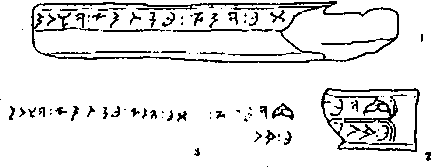
Publications:
Donner О. Sur Porigine de alphabet turc du Nord de I'Asie. - JSFO. 1896, 14, p.
42, Fig. XIX;
Melioransky P.M. Two silver vessels with Yenisei inscriptions. - ZVORAO. 1902,
vol. 14, p. 20-22, table I;
Smirnov Ya.A.I.The eastern silver. SPb., 1909, p. 5, 6, 11, table XCH, №168;
Darkevich V.P. Art metal of the East of 8-13 centuries. М., 1976, p. 9, table
20,5,6;
Kyzlasov I.L. Ancient Turkic runic writing of Eurasia, fig. 15,7,2, p. 50-54.
Reading attempts:
Melioransky P.M. Two silver vessels, p. 21,22.
The vessel is damaged by a plough in the place of the find. After delivery to the Archeological Commission (OAC) (1884) a üg and the handle with the inscription were sketched by A.Medvedev, then the find has been transferred to the Hermitage (1894), where it was studied by Ya.I. Smirnov. In 1896г. O.Donner, developing a concept of the origin of the Orkhon-Yenisean script, first published as the example of similar writing a sketch of the Sediyar inscription, made from the photos given to him by V.G. Tizengauzen. Ya.I. Smirnov brought the attention to P.M. Melioransky, who published in 1902 a sketch of the jug, A. Medvedev's sketch and the photos of the inscription. Quite familiar with the Asian runic writing, the outstanding Türkologist noted the presence in the inscription of the "several signs (or at least variations), hitherto unknown in the Orkhon-Yenisean writing", and, having discussed all the complications, published an attempt of decoding of the text on the basis of the S. Siberian Türkic alphabet. Having compared with it the forms of the Sediyar letters, P.M. Melioransky suggested that they belong to the end of the 8-9 century. This dating has been accepted by I.A. Talitskaya. OAC suggested a later date, 10-11 centuries.
The vessel was included in the Ya.I. Smirnov atlas
under № 168, published
the photo of the overall view of the jug and both parts of its handle, and
the A. Medvedeva's sketch. The reading of the inscription by P.M. Melioransky
was also given . The photo of the vessel, the long part of the handle and the
A. Medvedeva's sketch were re-published by V.P. Darkevich in 1976. Based on the
dating of the letters by P.M. Melioransky and the analogies in the paintings of
the 7-8 centuries he attributed the vessel to the 8th century. In turn, the runic
text served V.P. Darkevich as one of the reasons for determination of the place
of the manufacturing of the jug: "Judging by the Turkic inscription, it was made
in the east of the Central Asia". The story of the inscription's study, its
sketch and paleographic definition were published in 1990 by the author of
these lines. The epigraphical analogies determine the date of the text as the
8-9 centuries, and the place of its manufacturing is allowed to be considered
in the Eastern Europe.
On the published by all researchers images, precisely transmitting the original
in the exposition of the State Hermitage, are well distinguishable the 19
preserved signs the of the first and 4 signs of the second line of the
inscription. P.M. Melioransky considered that on the not preserved part of the
handle could be placed 11-17 signs, and by our calculations could be no more
than 13 signs. It is rather important that O.Donner's sketch reproduced two
more signs probably placed to the left of the break and later lost, and not
noticed by the other researchers. Judging by their place, these signs could also
be on the separate fragment which was not contiguous to the right or left part
of the first line. We believe also that in the end of the second line
P.M. Melioransky accepted on the A. Medvedev's sketch as a "half-letter" the
crack in the metal along which has fallen off a small slice of the handle which
later did not get to the Hermitage. Anyhow, nowadays we have 25 signs of the
Sediyar inscriptions, five of which are the vertically oriented colons.
K 2/1-4. Onoshat
Four isolated inscriptions-graffiti at the bottom of a silver dish.
The inscription K 2/1 is made inside of the engraved circle, and the eight making it signs (height 0,9-0,6, mostly 0,7-0,8 sm) are placed by an arch-wise line with the base of 5 and height 2,7 sm. Reference to letters of the second on the right and extreme at the left (separated from the text by a space of 1 sm) raises the doubts.
The inscription K 2/2 is placed below the previous, consisting of three very thinly marked letters (height 0,5, 0,5 and 0,9 sm). Located in 1,2 sm more to the right of the inscription the zigzag sign does not belong to it, for it is cut rather deeply and precisely (similarly to the text K 2/1).
The inscription K 2/3 is on the external side of the first circle and covers the second carved circle. To the text made by a lighter cutter than the K 2/1 belong, undoubtedly, four letters (height from 0,8 to 0,6, one is 0,4 sm). The short stroke which is more to the right, and an extreme left tracing, apparently, do not belong to the text and are made by another tool.
The inscription K 2/4 is placed above the line K 2/1, 2,5-2,6 sm outside the ring leg of the dish and by the form of a line depends on last. Probably do not belong to the letters the extreme right and left signs (spaced by one sm). The other five, undoubtedly alphabetic, signs are cut out clearly and have height of 0,7-0,8 sm (one is 0,6 sm).
Date 8-9 century.
Found in 1892 together with silver grivnas of the 9th
century on a plow land near v. Onoshat in Sepychevsk volost Ohansk district of
the Perm province (nowadays Vereshchagin district of the Perm province) in the
basin of the river Sepych - the left tributary of the river Lysva (fig. 1,9).
Stored in State Hermitage, cat. № S-22.
It was stored in the Institute of the Archeology of the Russian Academy of Sciences where nowadays is only one part of it, the "Khumarian - 1".
K 2.1 per Ya.I. Smirnov, 2 - sketch of the author (I.L Kyzlasov)
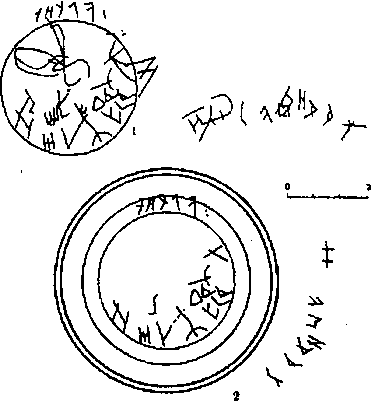
Publications:
Smirnov Ya.I. Eastern silver, tab. XIII, XCH;
Kyzlasov I.L. Ancient Turkic runic writing of Eurasia, fig. 15,3-5, p. 58-60.
Attempts of reading: not published.
In 1909. Ya.I. Smirnov published the Iranian dish № 105 among numerous samples of the eastern silver. On its back were grooved various lines and signs, and also the runic inscriptions were published as a sketch. The dish was repeatedly analyzed as a sample of the artisanship, however its runic tracings did not attract the attention of the epigraphists. Meanwhile the very fact of the existence of the secondary inscription served V.P. Darkevich as the basis for the definition of the upper date of the manufacturing of the dish, not later than the 8th century, for, in the opinion of the researcher, " the latest runic texts from Mongolia and Eastern Turkestan are dated by the middle of the 9th century". A nominal dating of the treasure, by I.A. Talitskaya, 6-9th century. With some hesitation B.I. Marshak dates the dish to the first half of the 8th century. We studied the dish due to B.I. Marshak's assistance. The separate four lines of inscriptions are made by different cutters and actually represent a small series of independent texts K 2/1-4. All other marks, in the extremely good-quality sketch of Ya.I. Smirnov, are made after the inscriptions or not connected to them. In our drawing missing is the zigzag line on the incomplete circle between the inscription 4 and the ring leg of the dish made by the same cutter, as last text
K 3. Khumarian - 1, 4, 5
Parts of one graffiti text on three fragments of the
sandstone blocks re-used for the construction of the walls of the fortress. A
horizontal line, probably, of 17 signs (between the eighth and the ninth is a
break in the stone erased one or two more signs; probably, not all initial
letters were preserved). Overall length not less than 95 sm, height of letters
- 6-7 sm (some signs are up to 11 sm).
Date - before the second half of the 9th - beginnings of the 10th century.
Found in 1960 during construction work in the Khumarian fortress in the upper
flow of the river Kuban, 11 km is above the city Karachaevsk (fig. 1,2).
K 3. Baichorov S.Ya. Ancient Turkic runic monuments, table 135
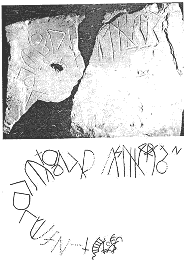
K 3. Sketch by the author (I.L.Kyzlasov, a segment, shown upside down)
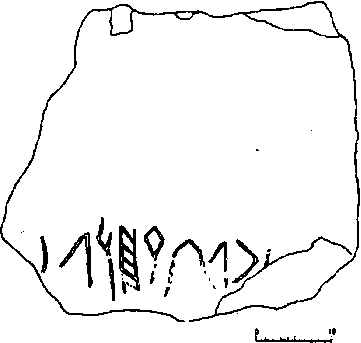
Publications:
Kuznetsov V.A. Inscriptions of the Khumarian fortress. - SA. 1963, N8 1, fig.
1,1,4, 3,2;
Scherbak A.M. Les inscriptions inconnues sur les pterres de Khoumara (au
Caucase du Nord) et le probleme de l'alphabet runique des turcs occidentaux. -
AOH. 1962, vol. 15, fasc. 1-3, Fig. 1;
Baichorov S.Ya. Ancient Turkic runic monuments, p. 174-178, table 136-139;
Kyzlasov I.L. Ancient Turkic runic script of Eurasia, fig. 11, p. 31-33.
Attempts of reading:
Baichorov S.Ya.North Caucasian area of the Ancient Turkic runic writing.
Autoreferate of the Ph.D.
dissertation. М., 1977, p. 22;
Baichorov S.Ya. The Ancient Turkic runic monuments, p. 178.
Transcription:
Ëgnbeh (=
Ëgünbeh)
b(е)lüg
(=bеlüg)
d'og (e)ni
(e)sh oyusht(у)k. Ijden
el (о)l
Ttranslation:
Monument of Egünbek,
memorial house (lodge) -
sanctuary excavated we. (He) will
appear before god
K 4. Khumarian - 2, 3
Parts of one graffiti text on two fragments of the
sandstone blocks re-used for the construction of the
fortification.
Arch-like line of 16 signs. The base of
the arch is about 1,5, and
the the height about 2 m. The sizes of signs vary
from 7-8 to 20 and more sm.
Date - before the second half of the 9th - beginnings of the10th
century.
Found in 1960 at the same point.
Was stored in the
Institute of Archeology of the Russian Academy of Sciences where nowadays it is
not found.
K 4. Was stored in the Institute of Archeology of the Russian Academy of Sciences where nowadays it is not found.
K 4. Baichorov S.Ya. Ancient Turkic runic monuments, tab. 136, 140


Publications:
Kuznetsov V.A. Inscriptions,
fig. 1,2,3;
Minaeva T.M. To
the history of the Alans
of the Upper Kuban area on the archeologic data.
Stavropol, 1971; p. 218 fig.
39,4
Baichorov S.Ya. Ancient
Turkic runic monuments, p. 168-174, table
130-135.
Attempts of reading:
Baichorov S.Ya. North
Caucasian area, p. 22;
Baichorov S.Ya. The Ancient
Turkic runic monuments, with. 174.
Transcription:
Djgut(u)r (e)
kdj belüg
tiketüki dj(а)l
(e)ki kidj oy(u)u
(= kidje oiuu) oyd(uk)
Translation:
In dügutur second (i.e. in the second month of
year of tur, a mountain goat), in year of
completion of monument, two small ornaments engraved
(we)
K 5. Khumarian - 6
Graffiti on the sandstone
block, re-used for the construction of the
fortification. Three horizontal lines: 8, 8 and 7 signs. Their length
is accordingly about 43,5 sm and 44-45 sm.
Height of signs from 3,5 to 9 sm, mostly 6,5-7,5 sm.
Date - before the second half of the 9th - beginnings of the10th
century.
Found in 1962 at the same point.
Stored in the Karachaevo-Circassian museum of study
of local lore.
K 5. Stored in the Karachaevo-Circassian museum of study of local lore.
Baichorov S.Ya. Ancient Turkic runic monuments, tab. 144-2.
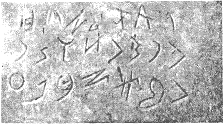
Baichorov S.Ya. Ancient Turkic runic monuments, tab. 145-2.

Publications:
Kuznetsov V.A. Inscriptions,
fig. 2,7;
Scerbak A.M. Les inscriptions, Fig. 3;
Baichorov S.Ya. Inscription
of the Khumarian fortress. - ST 1974, № 4, with.
90-92;
Baichorov S.Ya. The Ancient Turkic runic monuments,
tab. 144, 145.
Attempts of reading:
Baichorov S.Ya. Inscription
of the Khumarian fortress, p. 90, 92;
Baichorov S.Ya. North
Caucasian area, p. 22, 23;
Baichorov S.Ya.. The Ancient Turkic runic monuments,
p. 183.
Transcription:
1) Djgut(u)r
üch(е)m(и)g
2) Mengchur (e)l(i)nche
3) ur bit i
ëgig(е)n
Translation:
1) In dügutur third (i.e. in the third month of
year of tur, the mountain
goat)
2) Mengchur in his state
3) engraved inscriptions gave
praise
K 6. Khumarian - 7
Graffiti on sandstone block, re-used
for construction of the
fortification wall and broken in two. A horizontal
line of 10 signs. Overall
length about 52 sm, height of letters from 4,3 to 7,5 sm,
mostly 5,5 sm.
Date - before the second half of the 9th - beginnings of the10th
century.
Found in 1962 at the same point.
Stored in the Karachaevo-Circassian museum of study
of local lore.
K 6. Stored in the Karachaevo-Circassian museum of study of local lore.
K 6. Baichorov S.Ya. Ancient Turkic runic monuments, tab. 142
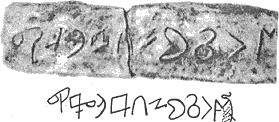
Publications:
Kuznetsov V.A. Nadpisi,
fig. 2,2;
Baichorov S.Ya. Inscription of the Khumarian
fortress, p. 92;
Baichorov S.Ya. The Ancient Turkic runic monuments,
tabl. 141, 142;
Habichev M.A. The word-formation and etymological
analysis of the Karachai
etnonyms. - Actual problems
of the Karachai-Balkarian
and Nogay languages.
Stavropol, 1981, p. 39.
Attempts of reading:
Habichev M.A. The word-formation and etymological
analysis: p. 39, 40.
Baichorov S.Ya. Inscription of the Khumarian
fortress:. p. 93;
Baichorov S.Ya. North Caucasian area,
p. 22;
Baichorov S.Ya. The Ancient Turkic runic monuments,
p. 181;
Transcription:
Djgut(u)r
üch(e)mge
minge...
Translation:
By dügutur third
(i.e. to the third month of the year of
tur, the mountain goat),
eternity (i.e. a memorial)...
K 7. Khumarian - 8
Grafitti on sandstone block, re-used
for construction of the
fortification. Two horizontal lines of eight signs.
The dinensions of the
monument are unknown.
Date - before the second half of the 9th - beginnings of the10th
century.
Found in 1962 at the same point.
It was destroyed before the
arrival of the experts. The known in the literature sketch of
a student A.D. Besleneev
is, probably, an inexact copy of the second and third lines K 5 (table
II).
K 7. It is destroyed before arrival of experts
K 7. Baichorov S.Ya.Ancient Turkic runic monuments, table 143
![]()
Publications:
Kuznetsov V.A.Nadpisi, fig. 3,1.
Attempts of reading:
Baichorov S.Ya. Inscription of the Khumarian fortress, p. 93;
Baichorov S.Ya. North Caucasian area, p. 22;
Baichorov S.Ya. The Ancient Turkic runic monuments, p. 181.
Transcription:
1).. (e)g(i)nch bengd'(u)r - (e)l(i)nche
2) gu üm ëg(i)g(е)n
Translation:
1).. Second (i.e. in the second month of year...)
Bengdür in his state
2) With help this (or signs
these) has praised
K 8. Khumarian -10
Graffiti on sandstone
block of the fortification. A horizontal line
of three signs. The sizes are unknown.
Date - before the second half of the 9th - beginnings of the10th
century.
Found at the same point. Time of the find is not
known.
The monument is known only from the sketch
by S. Belobrov, the inhabitant of
the village Sarytüz
of the Karachai district.
K 8. The monument is known only from the sketch of the villager S. Belobrov
K 8. Baichorov S.Ya. Ancient Turkic runic monuments, table 149
![]()
Publications:
Baichorov S.Ya. North Caucasian area, p. 5, fig. 14;
Baichorov S.Ya. The Ancient Turkic runic monuments, table 149.
Attempts of reading:
Baichorov S.Ya.Ancient Turkic runic monuments, p. 186.
Transcription:
Dog (?)
Translation:
memorial , funeral " (?).
The Khumarian fortress belongs to the Saltovo-Mayak culture and is dated, per verbal message of S.A. Pletneva, by the second half of the 9th - the beginning of the 10 c. Inscriptions have been cut out on sandstone blocks before the erection of the facings of the fortifications. S.Ya. Baichorov cites the data that stones with inscriptions served as steps of the ladder leading to the citadel that does not prevent him to also specify here, however, on their location in the wall of the fortress. The researcher revealed the new indications of the secondary usage of the written monuments at the construction of the fortifications (partial burn and finishing of the blocks, traces of imbedded iron reinforcements).
The remains of the fortress have drawn attention of the regional specialists in the middle of 19 century, but the inscriptions on the stones have been found only in 1960. Probably, inhabitants knew about them earlier. Judging by the figure published without comments, already in 1960 one plate with an inscription was stored at the local school. In the same year V.A. Kuznetsov surveyed the inscriptions and took them out from the fortress. In 1962 the researcher has studied new finds of plates with texts, and published all inscriptions known to him in 1963. Two inscriptions ("Khumarian - 1" and K 5) with V.A. Kuznetsov's photos have been published in 1962. by A.M. Scherbak. Sketch K 1 was published by A.M. Scherbak in 1971 and republished by J. Nemeth. In 1971. T.M. Minaeva published the observations and a sketch of teacher S.D. Mastepanov from which follows that pieces with inscriptions K 2 and K 3 originally made one plate (size 1 x 0,6 x 0,18 м) and ta single text (K 4). The researcher believed that she was publishing a brand new written monument. Though in the1977 the inscription was identified by S.Ya. Baichorov, in 1983 the mistake has been repeated by H.H. Bidjiev in the publication of the collection for the sketches of the Khumarian texts. He also admitted other errors: on fig. 49 No 5 is reproduced the same plate as No 1 (K 1), but turned around; No 7 ("a casual find of the archeologist U.Ü. Elkanov ") shows merged together (it should be seen from right to left, starting from the bottom line) inscriptions K 6 and K 5.
. In 1971 G.F. Turchaninov attributed the Khumarian texts to the Iranian speakers (Kosogian), some of their signs were entered into the comparative - paleographic table, and suggested their phonetic value. In 1974. S.Ya. Baichorov made an attempt of reading the three inscriptions (K 5 - K 7) on the basis of the Ancient Turkic runic alphabets. In 1977 he also read the other monuments, and put in order the inscriptions, the result of which assembled all of them as five fragments of one text. However his study remained unpublished. In 1981 M.A. Habichev offered his understanding of K 6 as a Türkic language inscription. In 1989. S.Ya. Baichorov published description, sketches, a history of the study and, the most valuable, a series of photos of the Khumarian inscriptions, incontestably testifying that the original complete blocks of stone with one text were broken down into isolated fragments. So, one written monument K 3 appeared as stones X 1, X 4 and X 5, was confirmed the view on the unity of the text K 4 consisting of the fragments X 2 and X 3. S.Ya. Baichorov gives some data (without time and conditions of detection) about one more inscription of the Khumarian fortress (K 8) which sketch was published in 1977 without any comments.
Thus, the materials published by the researchers allow us to take into account the six Khumarian inscriptions, two of which (K 7, K 8) are represented by non-professional sketches (table II). In the funds of the Institute of Archeology of the Russian Academy of Science it was possible to find and study the original X 1 (the beginning of the K 3), that has led to better details of the shape of the inscription. The remaining monuments were studied by the archival and published pictures that to a certain degree was helped by the specifics of the texts, with their large signs cut deeply into the fairly hard sandstone. The monuments received a paleographic definition. The newly received circumstances necessitated a respective alteration of indexes of these and other Kuban texts.
K 9. Mayaki
Graffiti on a burnt surface of a fragment of an amphora. A horizontal line of
17 whole and one partly preserved signs. Overall length of 10,4 sm, height of
signs 0,6-0,7 sm (one 0,5 and one 0,9 sm).
Date - 8th - 9th century.
Found in 1976 in the area of a burial ground near ancient village "Mayaki" on
the right bank of the river Donets (fig. 1,7) by S.I. Tatarinov and I.V.Kopyl.
Found on the surface.
Stored in the State Hermitage, cat. № 2763/1.
К 9. Маяки
Граффито на обожженной поверхности обломка амфоры. Горизонтальная строка из 17 целых и одного частично сохранившегося знака. Общая длина 10,4 см, высота знаков 0,6-0,7 см (однажды 0,5 и 0,9 см).
Дата - 8-9 в.
Обнаружено в 1976 г. на площади могильника близ селища Маяки на правом берегу р. Донец (рис. 1,7) С.И. Татариновым и И.В. Копылом. Подъемный материал.
Хранится в ГЭ, инв. № 2763/1.
K 9. A sketch of the author (I.L.Kyzlasov)
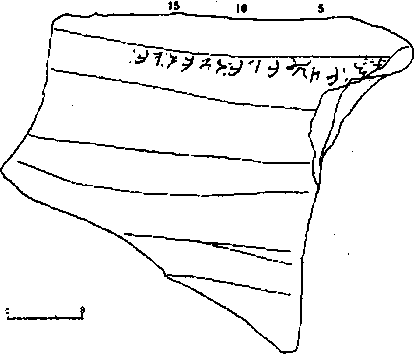
K 9. Baichorov S.Ya. Ancient Turkic runic monuments, table 122
![]()
Publications:
Klyashtorny S.G. Khazarian inscription on an
amphora from a fortress Mayaki. - SA. 1979, № 1;
Kyzlasov I.L. Ancient Turkic runic writing of Eurasia,
fig. 16,7, p. 54-56.
Attempts of reading:
Klyashtorny S.G. Khazarian inscription;
Transcription:
X arka X irkir ak achyk
bor
Translation:
X (units)
total; here X (measures) fits.
White dry wine
Baichorov S.Ya. Ancient Turkic runic monuments, p. 160, 161.
Transcription:
... En (e)sheche o (e)n...
Translation:
... vessel of house (lodge), this is house (lodge)
In the literature and the inventory book of the State Hermitage where the find is stored, is noted that the fragment is taken from the fortress of the Saltovo-Mayak culture. On
the split the field code "Mayaki - 76 III-th Al. m-k, p.m " was preserved, pointing that the fragment is found on the territory of the burial ground. The publication of the picture, the sketch, attempts of reading the inscription and attempt of its paleographic comparison with a number of runic monuments carried out S.G. Klyashtorny in 1979, S.Ya. Baichorov gave in 1989 his impression from the picture of the text and his reading. Seventeen preserved signs on the inscription represent the final part of the text containing 4 word-dividing vertical colon signs. The first sign on an inscription survived fragmentary, as an arch. The sixth, under the plausible assumption of S.G. Klyashtorny, is not the letter. Such opinion of the researcher about the second sign of the text is based on an erroneous, as becomes clear in a close study of the original, addition to it of a horizontal scratch made during manufacturing of the vessel on the potter's table. Actually here is a character similar to the fourteenth sign (table III, № 12). We understood differently also the twelfth sign on the inscription (№ 10). The new sketch of the inscription was published in 1990.K 10. Khumarian - 9
Grafitti on
the sandstone block from a wall of the citadel of the fortress. A horizontal line, probably, of 6-7 signs. Data for the sizes not available.Date - second half of the 9th - beginning of the 10th century.
Found in the Khumarian fortress during H.H.Bidjiev's excavation in 1977.
Stored in the Karachaevo-Circassian museum of study of local lore (?).
K 10. Stored in the Karachaevo-Circassian museum of study of local lore.
K 10. Baichorov S.Ya.
Ancient Turkic runic monuments, table 150

Publications:
Bidjiev
H. H. Digs of the fortress Humara in 1977. - Questions of the medieval history of the peoples of Karachai - Circassia. Cherkessk, 1979, fig. 5;Baichorov S.Ya. A Khumarian fortress. Cherkessk, 1983, fig. 49,8, p. 82, 84, 92;
Baichorov S.Ya. Ancient Turkic runic monuments, table 150.
Attempts of reading: not published.
In addition to the listed above, in a fortress in 1977 were found signs painted on the wall of the fortress. H.H.Bidjiev, probably correctly, classifies them as tamgas. One of the cut on the stones signs could be considered as alphabetic, but we have no necessary description. In 1981 S.Ya. Baichorov published his sketches for K 10 and the signs made with ochre.
Inscription on the handle of the vessel, drawn on
raw clay. Horizontal line of six signs with height from 1 to 2 sm (mostly 1,7-1,8 sm). Overall length 4,7 sm.Date - 11th - 12th century.
Found in 1983 at A.F.Kochkina's excavation on the Bilyar fortress (river Small.Cheremshan, the right tributary of the river BigCheremshchan, the left tributary of the river Volga) (fig. 1,5).
The place of storage in publications was not stated.
К11.
Per A.F.Kochkina sketch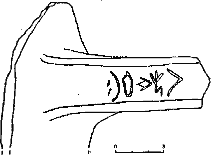
Publications:
Kochkina A.F.
Khalikov A.H. Runicheskite enatsi and inscriptions from Voljka Blgarija and tehnite dunavski paraleli. - Archeology. Sofia, 1988, N9 3, fig. 7.
Attempts of reading:
Kochkina A.F.Runic signs, p. 79;
Khalikov I, Kh.
Runic signs, p. 52;
Baichorov S.Ya. Ancient Turkic runic monuments, p. 253.
Transcription:
At chëmr(e) n:
Translation:
From this ladle (jug)...
The characters have been etched on the raw clay. The text was completely preserved. A.F.Kochkina, who published in 1985 the picture of the inscription and an attempt of its reading, assumes that the artifact is dated by 11th -12th century. In 1988 A.H. Khalikov published other photo of the subject with the text, offerring one more version of the reading and supported a later dating of the find, 12th-13th century, the end of the pre-Mongolian period. In 1989 S.Ya. Baichorov, having re-published materials, offered a new reading. The reproduction of the inscription and its paleographic analysis were published in 1990.
K 12. Jitkov
Grafitti on a horn overlay of a
fighting bow. One line of 23 letters. The overall
length of 7,3 sm, with the height of the
letters from 0,2 to 0,5 sm (mostly about 0,3 sm).
Date - first third of the 8th
century.
Found in 1986 by Y.I.Bespalyi
during excavation of a barrow in the
burial grounds Jitkov II in
the basin of the river Manych east of the Bataysk (fig. 1,12).
Stored in the Azov museum of
the local lore .
Публикации:
Кочкина А.Ф. Рунические знаки на керамике Биляра. - СТ. 1985, N9 4, рис. 3;
Халиков А.Х. Руническите энаци и надписи от Волжка България и техните дунавски паралели. - Археология. София, 1988, N9 3, рис. 7.
K 12.1 Per E.I. Bespalyi's sketch, 1-sketch of the author (I.L.Kyzlasov) per A.I. Semenova's photo
photo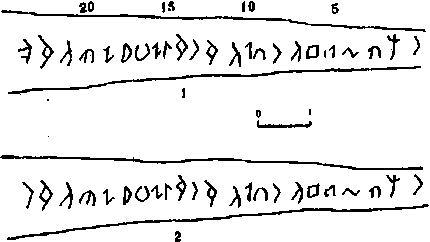
Publications:
Belinski
Semenov A.I. The revealing of the Central Asian elements in the culture of the early Middle Age nomads of the East Europe. - the Archeological collection of the State Hermitage. Issue 29. L., 1988 fig. 8.
Attempts of reading: not published.
The find is made in the burial No 1
of the kurgan No 4 plundered in an
antiquity on the burial grounds
of the Jitkov II, 6 kms from work
settlement Veselyi in the Rostov
region. By the finds of the coins,
a dirghem Nahr-Tira (98 AH./716
AD) and a solid of
the Leo III (717-720 AD)
the burial is dated by the first third
of the 8th century and made
in the kurgan with square trench.
In 1988 were twice published,
together with the brief data about the
burial, the sketches of the text,
in details differing from each other and from the
impressions of the author of these lines, received
from the study of the kindly given
by A.I.Semenov the slide of the
inscription . The corresponding sketch and paleographic definition of
the inscription were published in 1990.
3. THE DON-KUBAN SCRIPT (DK)
The inscriptions listed here contain letters equally used both in the Don, and in the Kuban alphabets.
DK 1. Soltykov Dish
Grafitti on the back a silver dish.
A line of seven signs.
Date is not clear.
Found before 1843. Belongs to P.D.Soltykov's addressless
collection.
Stored in the Office
of Coins and Antiquities of
the National Library in Paris.
DK 1. Per Ya.I.Smirnov's sketches
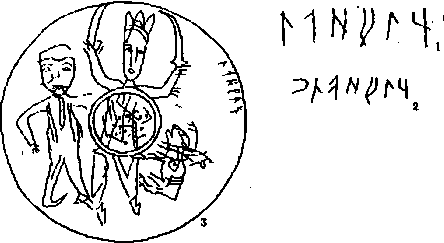
Publications:
Spitsyn A.A. Shaman images.
The Notes of Branch of Russian and
Slavic archeology of the Russian Archeological
Society. SPb., 1906, v. 8, issue
1, p. 46, fig. 14, 15;
Smirnov Ya.I. Eastern silver, p. 4, 7, 11, table X7,
ХСII, № 40.
Attempts of reading: not published.
V.P.Darkevich believes,
that the dish is of the Iranian
work of the 7th -
8th century, B.I.Marshak classified
it as Tokharistan second half of the
6th c. In the domestic literature as far as it is known,
it was published by A.A.Spitsyn in 1906 for the first
time per the Ya.I.Smirnov
sketches made in Paris. (In the published
pictures was preserved
the signature of the French artist: L. Sellier.) The Alas
of the Eastern silver of this researcher was known
to A.A.Spitsyn before its publication.
In addition to the sketch of the
bottom of the dish on along with
the secondary Ugrian images is also
reproduced the engraved 6-character
inscription, Ya.I.Smirnov published an enlarged
French copy of runic signs and, probably, his
own sketch made during his stay
in Paris. Ya.I.Smirnov's sketch differs in
the form of the third and especially
the fifth letter, and contains
seven letters. The specifics of this reproduction allow
to identify the inscription with
the monuments of the Don-Kuban writing.
The pleographic definition of the
monument and re-print of the
known sketches was done in 1990. The
Ugrian images on the dish,
classified mainly by the images
of the sabres, belong to
the 9th -10th
century. Probably also the
inscription should be dated
by the period close to the 8th
- 9th century.
DK 2. Afanasievo
Grafitti at the bottom of the
silver cup. Five signs. Data about
the sizes is not available.
Date - not earlier than the second half of the
8th century.
Found in 1932 in the plow
land in the vicinity
of the river Afanasieve of the
Züzden
district of the former Nijniy Novgorod territory
(nowadays the Kirov Province (i.e. Vyatka,
renamed in the Stalin period into Kirov - Translator's Note),
upper flow of the river Kama) in the
treasure (fig. 1, 0).
Stored in the Nijniy Novgorod Historiko-Archeological
museum.
DK 2 Per V.P.Darkevich and V.F.Chernikov
![]()
DK 2-1 Engravings on the shield of the handle on the Afanasief cup

Publications:
Darkevich V.P., Tchernikov V.F. New in study of
Central Asian torevtika. Afanasiev
treasure. - KSIA. 1971, issue 128, p. 113.
Attempts of reading: not published.
The inscription is known only by the sketch of V.P.Darkevich and V.F.Tchernikov, published in 1971 and re-published in 1990. Not clear in the published photos etchings are also on the shield of the handle of the Afanasiev cup. V.P.Darkevich is inclined to consider them to be runic inscriptions.
DK 3. Kirovo
Grafitti on the horn overlay of the
fighting bow. The line length 3,2 sm consist of three letters with
height 0,8 sm and the fourth sign of an unclear
shape.
Date - end of the 8th century.
Found in 1981. by L.S.Ilükov
during excavation of the Kirov IV
burial grounds (burial 13, kurgan
2) in the basin of the river Manych (fig. 1,71).
Stored in the Rostov State
University (?).
DK 3. Per L.S. Ilükov sketches

Publications:
Kyzlasov I.L. Ancient Türkic
runic writing of Eurasia, fig. 18,4, p. 66, 67.
Attempts of reading: not published.
In the burial together with the overlay of the bow were found a clay flask with a colourful pattern, similar to the Novocherkassk flasks, the objects of equipment and arms determining the belonging of the tomb to the Saltovo-Mayak culture. Especially important is the find of a dirghem of 777-779 AD. Burial is made by the grave pit (Bulgarian) ritual. Due to the courtesy of L.S.Ilükov the text was studied by the drawings of the overlay and the inscription given to the author and was published as a sketch in 1990.